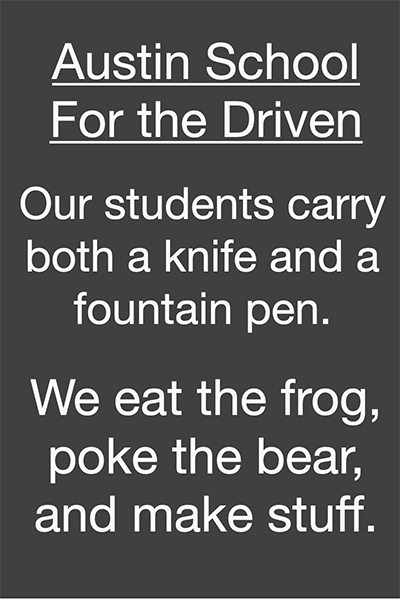Anxious minds: Teens and mental health
/In recognition of rising rates of anxiety disorders and depression among our teens and May as Mental Health Awareness Month, Alt Ed Austin is launching a two-part blog series by staff writer Shelley Sperry. We’ll also highlight some helpful mental health resources for parents, kids, and educators on our Facebook and Twitter feeds.
The umbrella term “mental health” covers a vast array of issues, and of course, we can’t be comprehensive in a few blog posts, so we’ll narrow the focus to what’s going on in schools and in our community to help kids with anxiety and depression. We want to help open up the conversation about all mental health issues, so please let us know via comments, here or on Facebook, if you have suggestions for resources or topics we should highlight in the future.
In this opening blog post, I’d like to just offer an overview and suggest a few options for anyone who wants to investigate further. Here are a few statistics from the Centers for Disease Control and National Institute of Mental Health:
About 8 percent of kids 12 to 17 report two weeks or more of mentally unhealthy days in the past month.
In 2014, an estimated 2.8 million adolescents aged 12 to 17 in the United States had at least one major depressive episode in the past year. This number represented 11.4 percent of the U.S. population aged 12 to 17.
Fully 25 percent of teens have experienced some form of anxiety disorder and for about 6 percent, this has caused “severe impairment.”
Depression affects about 10 percent of adolescents.
A 2015 Pew Research study based on parent surveys found that parents are most concerned about bullying and anxiety and depression among their kids. But often anxiety and depression are not as easy for teachers or parents to identify as behavioral problems. Students may want to hide their symptoms and may outwardly seem to be “good kids” and perfectionists, masking their challenges.
Because kids spend at least half—and sometimes more—of their waking hours at school, it’s essential that teachers, counselors, and school administrators be alert to signs of stress and distress among students. Yet despite the size of the problem, in most communities, schools suffer from a lack of mental health specialists. For example, in Wisconsin a major investigation determined that schools need twice as many psychologists and six times as many social workers as they have.
In the coming weeks, I look forward to looking at what’s happening in Austin’s schools to help teens cope with anxiety and depression, and offering some perspectives from educators, therapists, and social workers in the field.
Some helpful resources:
National Institute of Mental Health: part of the National Institutes for Health, NIMH is the lead federal agency for research on mental disorders.
Mental Health America: a nonprofit founded in 1909 and dedicated to helping people live mentally healthier lives. It has more than 300 affiliates across the country and does educational work in communities as well as advocating for legislation.
Back to School, a site with a wide variety of resources for kids, teachers, and parents. Check out the Mental Health 101 Infographic for kids.
Anxiety and Depression Association of America: a nonprofit organization founded in 1980 and dedicated to educating the public and professionals about phobias and anxiety disorders and their treatment, as well as assisting people in locating treatment in their area. Despite its name, depression is not a major focus.
Texas System of Care Data Dashboard: a downloadable PDF report on child and adolescent mental health and wellness in Texas.
“Recent Advances in Anxiety Disorders and Coping Skills”: a presentation available on YouTube by Dr. Erin Berman, National Institute of Mental Health
Centers for Disease Control, Mental Health Surveillance Among Children in the United States, 2005–2011: the first comprehensive report on children’s mental health in the country.
Caring for Every Child’s Mental Health, a part of the federal government’s Substance Abuse and Mental Health Services Administration (SAMHSA): this site offers a variety of resources for parents and young people.
“Finding Help, Finding Hope”: a forum available from SAMHSA on YouTube about what to do if you think your child may have a mental health problem.
“A Blueprint When Feeling Blue: How a Mental Health Diagnosis Can Be Empowering”: A personal essay, backed up with relevant research, by social worker and mental health expert Ashley Santangelo.
Free Mental Health and Addiction Resources, compiled by RehabCenter.net.
Shelley Sperry

















